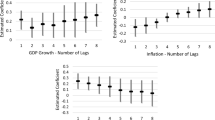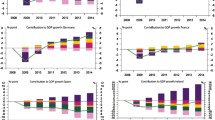Abstract
This paper studies the determinants of house prices in eight transition economies of central and eastern Europe (CEE) and 19 OECD countries. The main question addressed is whether the conventional fundamental determinants of house prices, such as GDP per capita, real interest rates, housing credit and demographic factors, have driven the observed house prices in CEE. We show that house prices in CEE can be explained well by the underlying conventional fundamentals and some transition specific factors, in particular institutional development of housing markets and housing finance and quality effects.


Similar content being viewed by others
Notes
The views expressed in this paper are those of the authors and do not necessarily represent the views of the BIS, the Oesterreichische Nationalbank or the ESCB.
Housing finance was generally unknown in socialist countries. Most urban housing was provided free of charge by employers or local authorities. For detailed descriptions of housing market institutions and housing finance in CEE, see OECD (2005) and Palacin and Shelburne (2005).
Private individuals in CEE own on average 80%–95% of the housing stock, and the ratio of owner-occupied housing in many countries exceeds 90% (OECD, 2005). In western Europe, the share of housing owned by private individuals ranges from about 60% in Austria and Sweden to 90%–95% in Belgium, Greece, Spain and Portugal; while the share of owner-occupied housing ranges from 38% in Germany to 80% in Ireland.
CEE countries that are members of the OECD are included only in the transition economies sample.
The large OECD sample comprises France, Germany, Japan, the United Kingdom and the United States. The small OECD sample comprises Austria, Belgium, Finland, Greece, Ireland, the Netherlands, Portugal and Spain from the euro area; plus Denmark, Norway, Sweden, Australia, Canada and New Zealand. The catching-up sample includes Greece, Ireland, Portugal and Spain.
Regression estimates with EBRD indicators and real wages exclude GDP per capita because of multicollinearity problems.
References
Annett, A . 2005: House prices and monetary policy in the euro area. IMF Country Report No. 05/266.
Attanasio, O and Weber, G . 1994: The UK consumption boom of the late 1980s: Aggregate implications of microeconomic evidence. Economic Journal 104: 1269–1302.
Ayuso, J, Martinez, J, Maza, L and Restoy, F . 2003: House prices in Spain. Economic Bulletin, Banco de España, October.
Breitung, J . 2000: The local power of some unit root tests for panel data. In: Baltagi, B (ed). Advances in Econometrics, Vol. 15: Non-Stationary Panels, Panel Cointegration, and Dynamic Panels. JAI Press: Amsterdam, pp. 161–178.
Girouard, N, Kennedy, M, van den Noord, P and André, C . 2006: Recent house price developments: the role of fundamentals. OECD Economics Department Working Paper No. 475.
Hadri, K . 2000: Testing for stationarity in heterogeneous panel data. Econometric Journal 3: 148–161.
Hofmann, B . 2001: The determinants of private sector credit in industrialised countries: do property prices matter? BIS Working Paper No. 108.
HM Treasury. (2003): Housing, consumption and EMU. HM Treasury: London.
Im, KS, Pesaran, H and Shin, Y . 2003: Testing for unit roots in heterogeneous panels. Journal of Econometrics 115: 53–74.
Kao, C and Chiang, M-H . 2000: On the estimation and inference of cointegrated regression in panel data. In: Baltagi, B (ed). Advances in Econometrics, Vol. 15: Non-Stationary Panels, Panel Cointegration, and Dynamic Panels. JAI Press: Amsterdam, pp. 179–222.
Kiss, G and Vadas, G . 2005: The role of the housing market in monetary transmission. Hungarian National Bank Background Study No. 3.
Levin, A, Lin, C-F and Chu, C-S . 2002: Unit root tests in panel data: Asymptotic and finite-sample properties. Journal of Econometrics 108: 1–24.
Maeso-Fernandez, F, Osbad, C and Schnatz, B . 2005: Pitfalls in estimating equilibrium exchange rates for transition economies. Economic Systems 29: 130–143.
Mihaljek, D . 2005: Free movement of capital, the real estate market and tourism. In: Ott, K (ed). Croatian Accession to the European Union, Vol. 3, Institute of Public Finance: Zagreb.
Mihaljek, D . 2006: Rapid growth of bank credit in central and eastern Europe: the role of housing markets and foreign-owned banks. Paper presented at the 12th Dubrovnik Economic Conference, June.
OECD. 2005: Housing finance markets in transition economies: Trends and challenges. OECD: Paris.
Ortalo-Magné, F and Rady, S . 1999: Boom in, bust out: Young households and the housing price cycle. European Economic Review 43: 755–766.
Palacin, J and Shelburne, R . 2005: The private housing market in eastern Europe and the CIS. UN Economic Commission for Europe Discussion Paper No. 6.
Sutton, G . 2002: Explaining changes in house prices. BIS Quarterly Review, September.
Terrones, M and Otrok, C . 2004: The global house price boom. In IMF, World Economic Outlook, IMF: Washington, April.
Tsatsaronis, K and Zhu, H . 2004: What drives housing price dynamics: cross country evidence. BIS Quarterly Review, March.
Acknowledgements
We are thankful for helpful comments on earlier drafts by Peter Backé, Václav Beran, Luci Ellis, Jan Frait, Miroslav Singer, Greg Sutton, Paul Wachtel, two anonymous referees and participants of seminars at the BIS and the ECB. We would also like to thank Ljubinko Jankov, Gergõ Kiss, Luboš Komárek, Davor Kunovac, Miha Leber, Mindaugas Leika, Andreja Pufnik and Marjorie Santos for the help in collecting the data for CEE countries.
Author information
Authors and Affiliations
Appendix
Appendix
Data description
GDP per capita in purchasing power standards, at current euro exchange rates (source: European Commission's AMECO database).
Interest rates for OECD countries are nominal lending rates for the whole economy (source: IMF International Financial Statistics). For CEE, a weighted average of lending rates on domestic and foreign currency loans was also used. Where complete series were not available, interest rates on foreign currency loans were proxied by the 3-month money market rate for the euro area (source: Eurostat's NewCronos). The weights were the respective shares of domestic and foreign currency loans in total housing loans.
CPI and inflation rates (to calculate real house prices and real interest rates) come from the WIIW's monthly database for CEE (except Estonia and Lithuania), and from International Financial Statistics.
Housing loans in OECD countries are proxied by total private loans as a share of GDP (source: International Financial Statistics). For Lithuania and Slovenia we use loans to households (source: central banks). For other transition economies, data on housing loans are available from central bank websites (for Croatia and Hungary, they were back casted using loans to households).
Equity price indices: Datastream; CEE nominal exchange rates against the euro: WIIW.
Unemployment rates: International Financial Statistics. Labour force: AMECO (annual data interpolated linearly to quarterly frequencies).
Real wages: nominal wages for the whole economy (or manufacturing) deflated by the CPI. (Sources: BIS, International Financial Statistics, WIIW).
Indices of institution reform of banks and non-bank financial institution: EBRD (interpolated linearly from annual to quarterly frequency).
Rights and permissions
About this article
Cite this article
Égert, B., Mihaljek, D. Determinants of House Prices in Central and Eastern Europe. Comp Econ Stud 49, 367–388 (2007). https://doi.org/10.1057/palgrave.ces.8100221
Published:
Issue Date:
DOI: https://doi.org/10.1057/palgrave.ces.8100221




